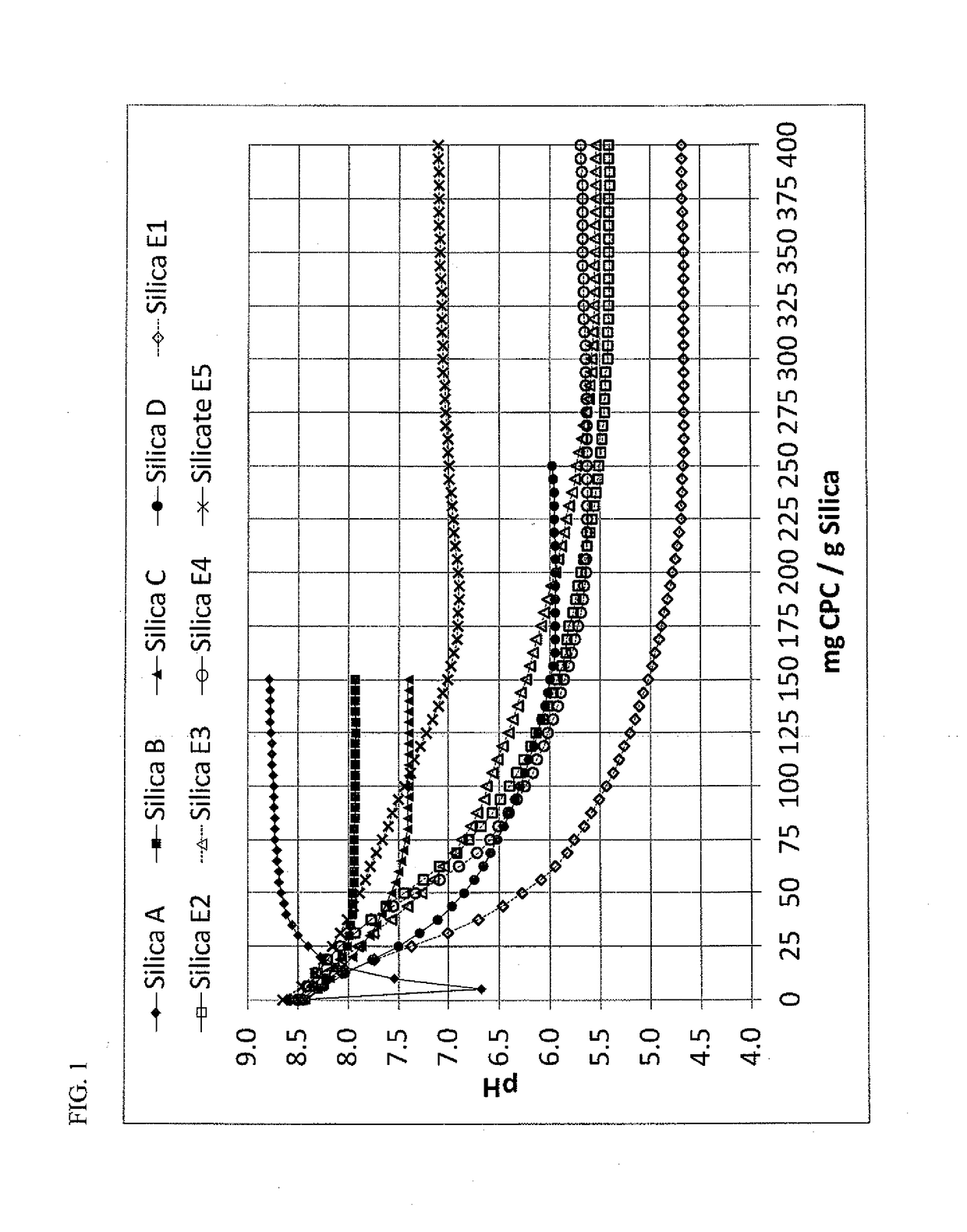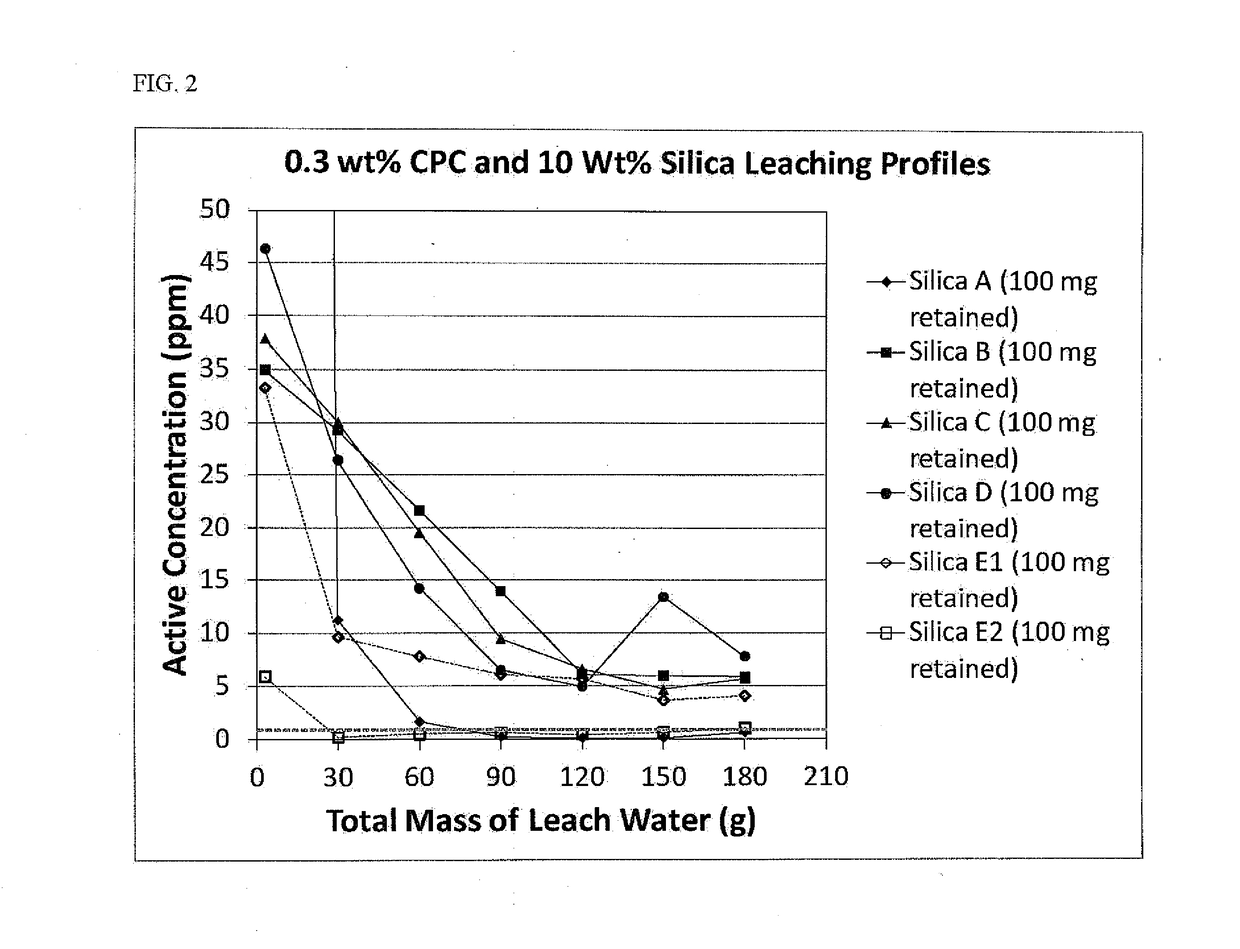Silica-Based Antimicrobial Oral Compositions
a technology of oral compositions and silica, applied in the field of oral compositions, can solve the problems of reducing the overall adsorption capacity of the selected antimicrobial agent, ineffective salivary levels to provide sufficient antimicrobial benefits, and limited compatibility
- Summary
- Abstract
- Description
- Claims
- Application Information
AI Technical Summary
Benefits of technology
Problems solved by technology
Method used
Image
Examples
examples
[0063]The invention is further illustrated by the following examples, which are not to be construed in any way as imposing limitations to the scope of this invention. Various other aspects, embodiments, modifications, and equivalents thereof which, after reading the description herein, may suggest themselves to one of ordinary skill in the art without departing from the spirit of the present invention or the scope of the appended claims.
[0064]The average particle size, or d50 or median particle size, refers to the particle size for which 50% of the sample has a smaller size and 50% of the sample has a larger size. Average particle size was determined via the laser diffraction method using a Horiba LA 300 instrument.
[0065]The BET surface areas disclosed herein were determined in accordance with the BET nitrogen adsorption method of Brunaur et al., J. Am. Chem. Soc., 60, 309 (1938), which is well known to those of skill in the art.
[0066]CTAB surface areas disclosed herein were determi...
examples 1-2
Particle Retentions Studies
[0067]Because particle retention is an important parameter for providing effective controlled release in applications where retention is not inherent, studies were conducted to determine the amount of silica that typically can be retained in the oral cavity. Although this level of retention may be altered through changes to the particle affinity to the hard tissues, soft tissues and biofilms of the oral cavity through surface modification with metal ions, quaternary ammonium species, bioadhesive polymers, etc., these experiments were viewed as a good baseline for the levels needed in order to provide effective release of the adsorbed antimicrobial agent.
[0068]In this study, a master 20 wt. % aqueous slurry of the desired silica was made using deionized water and one gram aliquots were distributed into clean pre-weighed fifteen milliliter tubes (200 mg silica). Seven subjects (varying in age and gender, six male and one female) each took a one gram aliquot ...
examples 3-11
Absorptive Capacity of the Silica and / or Silicate Material
[0070]The ability of various silica / silicate materials to absorb and provide controlled release of a cationic antimicrobial agent at sustained levels above the MIC of that agent was evaluated. For these examples, CPC was chosen, since it is a well-known and effective antimicrobial agent, with some literature indicating that it is more effective than chlorhexidine in-vitro, but suffers from low substantively in the oral cavity which renders it less effective in-vivo.
[0071]Table III summarizes the characteristics of the silica / silicate materials that were evaluated. A variety of silica / silicate grades are shown in Table III, ranging from highly CPC compatible (Silica A), several commercially available silica grades commonly used in dentifrice applications (Silica B, Silica C, Silica D), and the experimental materials (Silica E1, Silica E2, Silica E3, Silica E4, Silicate E5) that would be generally regarded as highly incompatibl...
PUM
| Property | Measurement | Unit |
|---|---|---|
| Length | aaaaa | aaaaa |
| Length | aaaaa | aaaaa |
| Fraction | aaaaa | aaaaa |
Abstract
Description
Claims
Application Information
 Login to View More
Login to View More - R&D
- Intellectual Property
- Life Sciences
- Materials
- Tech Scout
- Unparalleled Data Quality
- Higher Quality Content
- 60% Fewer Hallucinations
Browse by: Latest US Patents, China's latest patents, Technical Efficacy Thesaurus, Application Domain, Technology Topic, Popular Technical Reports.
© 2025 PatSnap. All rights reserved.Legal|Privacy policy|Modern Slavery Act Transparency Statement|Sitemap|About US| Contact US: help@patsnap.com



